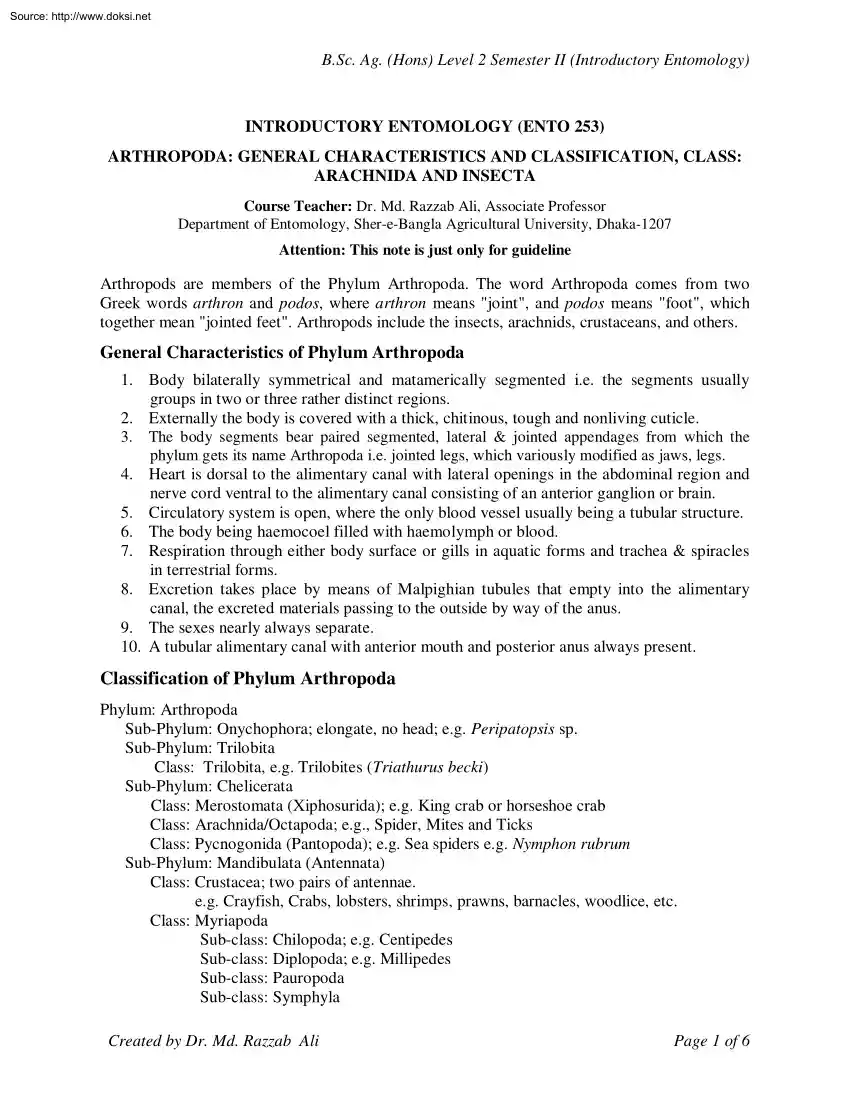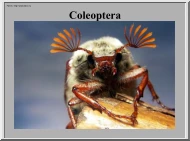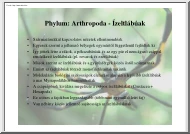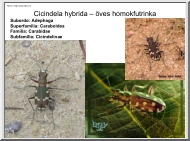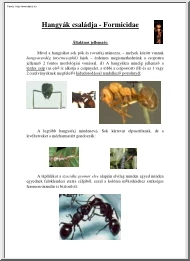Datasheet
Year, pagecount:2010, 6 page(s)
Language:English
Downloads:3
Uploaded:November 13, 2017
Size:3 MB
Institution:
-
Comments:
Sher-e-Bangla Agricultural University
Attachment:-
Download in PDF:Please log in!
Comments
No comments yet. You can be the first!Most popular documents in this category
Content extract
Source: http://www.doksinet B.Sc Ag (Hons) Level 2 Semester II (Introductory Entomology) INTRODUCTORY ENTOMOLOGY (ENTO 253) ARTHROPODA: GENERAL CHARACTERISTICS AND CLASSIFICATION, CLASS: ARACHNIDA AND INSECTA Course Teacher: Dr. Md Razzab Ali, Associate Professor Department of Entomology, Sher-e-Bangla Agricultural University, Dhaka-1207 Attention: This note is just only for guideline Arthropods are members of the Phylum Arthropoda. The word Arthropoda comes from two Greek words arthron and podos, where arthron means "joint", and podos means "foot", which together mean "jointed feet". Arthropods include the insects, arachnids, crustaceans, and others General Characteristics of Phylum Arthropoda 1. Body bilaterally symmetrical and matamerically segmented ie the segments usually groups in two or three rather distinct regions. 2. Externally the body is covered with a thick, chitinous, tough and nonliving cuticle 3. The body segments bear paired segmented,
lateral & jointed appendages from which the phylum gets its name Arthropoda i.e jointed legs, which variously modified as jaws, legs 4. Heart is dorsal to the alimentary canal with lateral openings in the abdominal region and nerve cord ventral to the alimentary canal consisting of an anterior ganglion or brain. 5. Circulatory system is open, where the only blood vessel usually being a tubular structure 6. The body being haemocoel filled with haemolymph or blood 7. Respiration through either body surface or gills in aquatic forms and trachea & spiracles in terrestrial forms. 8. Excretion takes place by means of Malpighian tubules that empty into the alimentary canal, the excreted materials passing to the outside by way of the anus. 9. The sexes nearly always separate 10. A tubular alimentary canal with anterior mouth and posterior anus always present Classification of Phylum Arthropoda Phylum: Arthropoda Sub-Phylum: Onychophora; elongate, no head; e.g Peripatopsis sp
Sub-Phylum: Trilobita Class: Trilobita, e.g Trilobites (Triathurus becki) Sub-Phylum: Chelicerata Class: Merostomata (Xiphosurida); e.g King crab or horseshoe crab Class: Arachnida/Octapoda; e.g, Spider, Mites and Ticks Class: Pycnogonida (Pantopoda); e.g Sea spiders eg Nymphon rubrum Sub-Phylum: Mandibulata (Antennata) Class: Crustacea; two pairs of antennae. e.g Crayfish, Crabs, lobsters, shrimps, prawns, barnacles, woodlice, etc Class: Myriapoda Sub-class: Chilopoda; e.g Centipedes Sub-class: Diplopoda; e.g Millipedes Sub-class: Pauropoda Sub-class: Symphyla Created by Dr. Md Razzab Ali Page 1 of 6 Source: http://www.doksinet B.Sc Ag (Hons) Level 2 Semester II (Introductory Entomology) Class: Insecta/Hexapoda Sub-class: Apterygota (4 Orders) Sub-class: Pterygota (27 Orders) Division: Exopterygota (18 Orders) Division: Endopterygota (9 Orders) GENERAL CHARACTERISTICS OF CLASS ARACHNIDA 1. A typical adult arachnid has two distinct body regions: cephalothorax and abdomen 2. The
anterior body region is cephalothorax, where cephalon (head) and thorax fused together, bears 4 pairs of legs- so the Arachnids called Octapoda (eight legs); a pair of chelicerae that are normally chelate; a pair of pedipalps that may be chelate. 3. All eyes are simple 4. They have no antennae 5. They have no wings 6. The posterior body region is abdomen, which is large but has no external gills or locomotor organs. 7. Excretion by Malpighian tubules 8. Respiration by book lungs and trachea 9. The sexes are separate and the reproductive organs are near the anterior portion of the abdomen and open through a single orifice. e.g spiders, mites, ticks etc. Fig.: Examples of arachnids belonging to the Class Arachnida Created by Dr. Md Razzab Ali Page 2 of 6 Source: http://www.doksinet B.Sc Ag (Hons) Level 2 Semester II (Introductory Entomology) GENERAL CHARACTERISTICS OF CLASS INSECTA 1. A typical adult insect has three distinct body regions: head, thorax and abdomen 2. The anterior
region of body is the head, which bears one pair of compound eyes, usually 3 simple eyes- each of which called ocelli, one pair of unbranched antennae and paired mouthparts. 3. The mid region of the body is the thorax, which is composed of three segments viz prothorax, mesothorax and metathorax. 4. Each thoracic segment usually bears a pair of legs, in many groups the second and third segments each bear a pair of wings. 5. Posterior region of the body is the abdomen, which consists of as many as 10-11 segments and has no legs or any locomotory organs but having mating organ. 6. The 8th, 9th and 10th abdominal segments usually have appendages modified for mating activities or egg laying. 7. Excretion by Malpighian tubules; respiration by pipe-like tracheae, exoskeleton or by gill; digestion by tubular digestive tract; blood circulation by open circulatory system; reproduction by paired reproductive organs. Muscular system, nervous systems also present. 8. Terrestrial and aquatic (rarely
marine) forms are available e.g Cockroaches, houseflies, mosquitoes, butterflies, bees, bugs, ants, beetles etc COMPARISON BETWEEN INSECT AND MITE Insect Insects are hexapoda (i.e six legs) Body is divided into head, thorax and abdomen; where head and thorax are separated. Antennae present Both simple and compound eyes present Wings may be present or not Size: small to large. Spider/Mite Mites are octapoda (i.e eight legs) Body is divided into cephalothorax and abdomen; head and thorax combined to form a cephalothorax. Antennae absent All eyes are simple Always wingless Size: minute. Figure. External morphology of Arthropods: adult insect (left) and adult spider (right) Created by Dr. Md Razzab Ali Page 3 of 6 Source: http://www.doksinet B.Sc Ag (Hons) Level 2 Semester II (Introductory Entomology) GENERAL CHARACTERISTICS OF SUB-CLASS APTERYGOTA 1. 2. 3. 4. 5. Wingless Metamorphosis primitive or no that is called Ametabola One
pair or more than one pair of appendages present in front of genital opening Mandible is attached into a specific position of head capsule Moulting continuous after sexual maturity. Fig. Wingless insect (adult silverfish) Fig. Life cycle of silverfish showing Ametabola GENERAL CHARACTERISTICS OF SUB-CLASS PTERYGOTA 1. 2. 3. 4. 5. Winged (alate) or secondarily wingless insects Metamorphosis incomplete or complete No appendage present in front of genital opening Mandible is attached into two specific position of head capsule Sexually matured adults do not moult. Fig. Winged insect (Butterfly in left) and secondarily wingless insect (Bed bugs in right Created by Dr. Md Razzab Ali Page 4 of 6 Source: http://www.doksinet B.Sc Ag (Hons) Level 2 Semester II (Introductory Entomology) GENERAL CHARACTERISTICS OF DIVISION EXOPTERYGOTA 1. Metamorphosis incomplete or simple that is called Hemimetabola [ 3 developmental stages include egg, nymph and adult] 2. Wings developed from external
portion of the body 3. Pupal instar absent or rare 4. Young generalized as nymph 5. Immature insects similar with adults Figure . Example of an insect (grasshopper) life cycle showing incomplete metamorphosis GENERAL CHARACTERISTICS OF DIVISION ENDOPTERYGOTA 1. Metamorphosis complete or complex that is called holometabola [4 developmental stages such as egg, larva, pupa and adult] 2. Wings developed from the internal portion of the body 3. Always accompanied by larval and pupal instar 4. Young generalized as larva 5. Immature insects externally differ with adults Fig. Example of an insect (butterfly) life cycle showing complete metamorphosis Created by Dr. Md Razzab Ali Page 5 of 6 Source: http://www.doksinet B.Sc Ag (Hons) Level 2 Semester II (Introductory Entomology) COMPARISON BETWEEN DIVISION EXOPTERYGOTA AND NDOPTERYGOTA EXOPTERYGOTA Metamorphosis incomplete or simple that are called hemimetabola [3 stages like egg, nymph & adult] Wings developed externally from the
body Immature insects similar with adults Young generalized as nymph Pupal instar absent or rare ENDOPTERYGOTA Metamorphosis complete or complex that are called holometabola [4 stages like egg, larva, pupa and adult] Wings developed internally from the body Immature insects externally differ Young generalized as larva Always accompanied by larval and pupal instar ORDERS OF CLASS INSECTA (According to Imms) Sub-Class: Apterygota Order 1. Thysanura – eg Bristle tails, silverfish Order 2. Diplura- eg Two pronged bristle tails Order 3. Protura- eg Proturans Order 4. Collembola- eg Spring tails Sub-Class: Pterygota Division: Exopterygota Order 5 Ephemeroptera- e.g Mayflies Order 6 Odonata- e.g Dragonflies, damselflies Order 7 Plecoptera- e.g Stoneflies Order 8 Orthoptera- e.g Crickets, grasshoppers, locusts Order 9 Phasmida- e.g Stick insects, leaf insects Order 10 Dermaptera- e.g Earwigs Order 11 Embioptera- e.g Web-spinners Order 12 Dictyoptera- e.g Cockroaches, mantids Order 13
Isoptera- e.g Termites Order 14 Zoraptera- e.g Zorapterans Order 15 Psocoptera- e.g Booklice, psocids Order 16 Mallophaga- e.g Biting lice, bird lice Order 17 Siphunculata- e.g Sucking lice Order 18 Hemiptera- e.g True bugs Order 19 Homoptera- e.g Leafhoppers, aphids, scale insects, cicadas Order 20 Thysanoptera- e.g Thrips Division: Endopterygota Order 21 Neuroptera- e.g Lacewings, antlions Order 22 Coleoptera- e.g Beetles & weevils Order 23 Strepsiptera- e.g Stylopids Order 24 Mecoptera- e.g Scorpion flies Order 25 Siphonaptera- e.g Fleas Order 26 Diptera- e.g True flies Order 27 Lepidoptera- e.g Butterflies, moths Order 28 Trichoptera- e.g Caddis flies Order 29 Hymenoptera- e.g Ants, bees, wasps, sawflies Created by Dr. Md Razzab Ali Page 6 of 6
lateral & jointed appendages from which the phylum gets its name Arthropoda i.e jointed legs, which variously modified as jaws, legs 4. Heart is dorsal to the alimentary canal with lateral openings in the abdominal region and nerve cord ventral to the alimentary canal consisting of an anterior ganglion or brain. 5. Circulatory system is open, where the only blood vessel usually being a tubular structure 6. The body being haemocoel filled with haemolymph or blood 7. Respiration through either body surface or gills in aquatic forms and trachea & spiracles in terrestrial forms. 8. Excretion takes place by means of Malpighian tubules that empty into the alimentary canal, the excreted materials passing to the outside by way of the anus. 9. The sexes nearly always separate 10. A tubular alimentary canal with anterior mouth and posterior anus always present Classification of Phylum Arthropoda Phylum: Arthropoda Sub-Phylum: Onychophora; elongate, no head; e.g Peripatopsis sp
Sub-Phylum: Trilobita Class: Trilobita, e.g Trilobites (Triathurus becki) Sub-Phylum: Chelicerata Class: Merostomata (Xiphosurida); e.g King crab or horseshoe crab Class: Arachnida/Octapoda; e.g, Spider, Mites and Ticks Class: Pycnogonida (Pantopoda); e.g Sea spiders eg Nymphon rubrum Sub-Phylum: Mandibulata (Antennata) Class: Crustacea; two pairs of antennae. e.g Crayfish, Crabs, lobsters, shrimps, prawns, barnacles, woodlice, etc Class: Myriapoda Sub-class: Chilopoda; e.g Centipedes Sub-class: Diplopoda; e.g Millipedes Sub-class: Pauropoda Sub-class: Symphyla Created by Dr. Md Razzab Ali Page 1 of 6 Source: http://www.doksinet B.Sc Ag (Hons) Level 2 Semester II (Introductory Entomology) Class: Insecta/Hexapoda Sub-class: Apterygota (4 Orders) Sub-class: Pterygota (27 Orders) Division: Exopterygota (18 Orders) Division: Endopterygota (9 Orders) GENERAL CHARACTERISTICS OF CLASS ARACHNIDA 1. A typical adult arachnid has two distinct body regions: cephalothorax and abdomen 2. The
anterior body region is cephalothorax, where cephalon (head) and thorax fused together, bears 4 pairs of legs- so the Arachnids called Octapoda (eight legs); a pair of chelicerae that are normally chelate; a pair of pedipalps that may be chelate. 3. All eyes are simple 4. They have no antennae 5. They have no wings 6. The posterior body region is abdomen, which is large but has no external gills or locomotor organs. 7. Excretion by Malpighian tubules 8. Respiration by book lungs and trachea 9. The sexes are separate and the reproductive organs are near the anterior portion of the abdomen and open through a single orifice. e.g spiders, mites, ticks etc. Fig.: Examples of arachnids belonging to the Class Arachnida Created by Dr. Md Razzab Ali Page 2 of 6 Source: http://www.doksinet B.Sc Ag (Hons) Level 2 Semester II (Introductory Entomology) GENERAL CHARACTERISTICS OF CLASS INSECTA 1. A typical adult insect has three distinct body regions: head, thorax and abdomen 2. The anterior
region of body is the head, which bears one pair of compound eyes, usually 3 simple eyes- each of which called ocelli, one pair of unbranched antennae and paired mouthparts. 3. The mid region of the body is the thorax, which is composed of three segments viz prothorax, mesothorax and metathorax. 4. Each thoracic segment usually bears a pair of legs, in many groups the second and third segments each bear a pair of wings. 5. Posterior region of the body is the abdomen, which consists of as many as 10-11 segments and has no legs or any locomotory organs but having mating organ. 6. The 8th, 9th and 10th abdominal segments usually have appendages modified for mating activities or egg laying. 7. Excretion by Malpighian tubules; respiration by pipe-like tracheae, exoskeleton or by gill; digestion by tubular digestive tract; blood circulation by open circulatory system; reproduction by paired reproductive organs. Muscular system, nervous systems also present. 8. Terrestrial and aquatic (rarely
marine) forms are available e.g Cockroaches, houseflies, mosquitoes, butterflies, bees, bugs, ants, beetles etc COMPARISON BETWEEN INSECT AND MITE Insect Insects are hexapoda (i.e six legs) Body is divided into head, thorax and abdomen; where head and thorax are separated. Antennae present Both simple and compound eyes present Wings may be present or not Size: small to large. Spider/Mite Mites are octapoda (i.e eight legs) Body is divided into cephalothorax and abdomen; head and thorax combined to form a cephalothorax. Antennae absent All eyes are simple Always wingless Size: minute. Figure. External morphology of Arthropods: adult insect (left) and adult spider (right) Created by Dr. Md Razzab Ali Page 3 of 6 Source: http://www.doksinet B.Sc Ag (Hons) Level 2 Semester II (Introductory Entomology) GENERAL CHARACTERISTICS OF SUB-CLASS APTERYGOTA 1. 2. 3. 4. 5. Wingless Metamorphosis primitive or no that is called Ametabola One
pair or more than one pair of appendages present in front of genital opening Mandible is attached into a specific position of head capsule Moulting continuous after sexual maturity. Fig. Wingless insect (adult silverfish) Fig. Life cycle of silverfish showing Ametabola GENERAL CHARACTERISTICS OF SUB-CLASS PTERYGOTA 1. 2. 3. 4. 5. Winged (alate) or secondarily wingless insects Metamorphosis incomplete or complete No appendage present in front of genital opening Mandible is attached into two specific position of head capsule Sexually matured adults do not moult. Fig. Winged insect (Butterfly in left) and secondarily wingless insect (Bed bugs in right Created by Dr. Md Razzab Ali Page 4 of 6 Source: http://www.doksinet B.Sc Ag (Hons) Level 2 Semester II (Introductory Entomology) GENERAL CHARACTERISTICS OF DIVISION EXOPTERYGOTA 1. Metamorphosis incomplete or simple that is called Hemimetabola [ 3 developmental stages include egg, nymph and adult] 2. Wings developed from external
portion of the body 3. Pupal instar absent or rare 4. Young generalized as nymph 5. Immature insects similar with adults Figure . Example of an insect (grasshopper) life cycle showing incomplete metamorphosis GENERAL CHARACTERISTICS OF DIVISION ENDOPTERYGOTA 1. Metamorphosis complete or complex that is called holometabola [4 developmental stages such as egg, larva, pupa and adult] 2. Wings developed from the internal portion of the body 3. Always accompanied by larval and pupal instar 4. Young generalized as larva 5. Immature insects externally differ with adults Fig. Example of an insect (butterfly) life cycle showing complete metamorphosis Created by Dr. Md Razzab Ali Page 5 of 6 Source: http://www.doksinet B.Sc Ag (Hons) Level 2 Semester II (Introductory Entomology) COMPARISON BETWEEN DIVISION EXOPTERYGOTA AND NDOPTERYGOTA EXOPTERYGOTA Metamorphosis incomplete or simple that are called hemimetabola [3 stages like egg, nymph & adult] Wings developed externally from the
body Immature insects similar with adults Young generalized as nymph Pupal instar absent or rare ENDOPTERYGOTA Metamorphosis complete or complex that are called holometabola [4 stages like egg, larva, pupa and adult] Wings developed internally from the body Immature insects externally differ Young generalized as larva Always accompanied by larval and pupal instar ORDERS OF CLASS INSECTA (According to Imms) Sub-Class: Apterygota Order 1. Thysanura – eg Bristle tails, silverfish Order 2. Diplura- eg Two pronged bristle tails Order 3. Protura- eg Proturans Order 4. Collembola- eg Spring tails Sub-Class: Pterygota Division: Exopterygota Order 5 Ephemeroptera- e.g Mayflies Order 6 Odonata- e.g Dragonflies, damselflies Order 7 Plecoptera- e.g Stoneflies Order 8 Orthoptera- e.g Crickets, grasshoppers, locusts Order 9 Phasmida- e.g Stick insects, leaf insects Order 10 Dermaptera- e.g Earwigs Order 11 Embioptera- e.g Web-spinners Order 12 Dictyoptera- e.g Cockroaches, mantids Order 13
Isoptera- e.g Termites Order 14 Zoraptera- e.g Zorapterans Order 15 Psocoptera- e.g Booklice, psocids Order 16 Mallophaga- e.g Biting lice, bird lice Order 17 Siphunculata- e.g Sucking lice Order 18 Hemiptera- e.g True bugs Order 19 Homoptera- e.g Leafhoppers, aphids, scale insects, cicadas Order 20 Thysanoptera- e.g Thrips Division: Endopterygota Order 21 Neuroptera- e.g Lacewings, antlions Order 22 Coleoptera- e.g Beetles & weevils Order 23 Strepsiptera- e.g Stylopids Order 24 Mecoptera- e.g Scorpion flies Order 25 Siphonaptera- e.g Fleas Order 26 Diptera- e.g True flies Order 27 Lepidoptera- e.g Butterflies, moths Order 28 Trichoptera- e.g Caddis flies Order 29 Hymenoptera- e.g Ants, bees, wasps, sawflies Created by Dr. Md Razzab Ali Page 6 of 6
